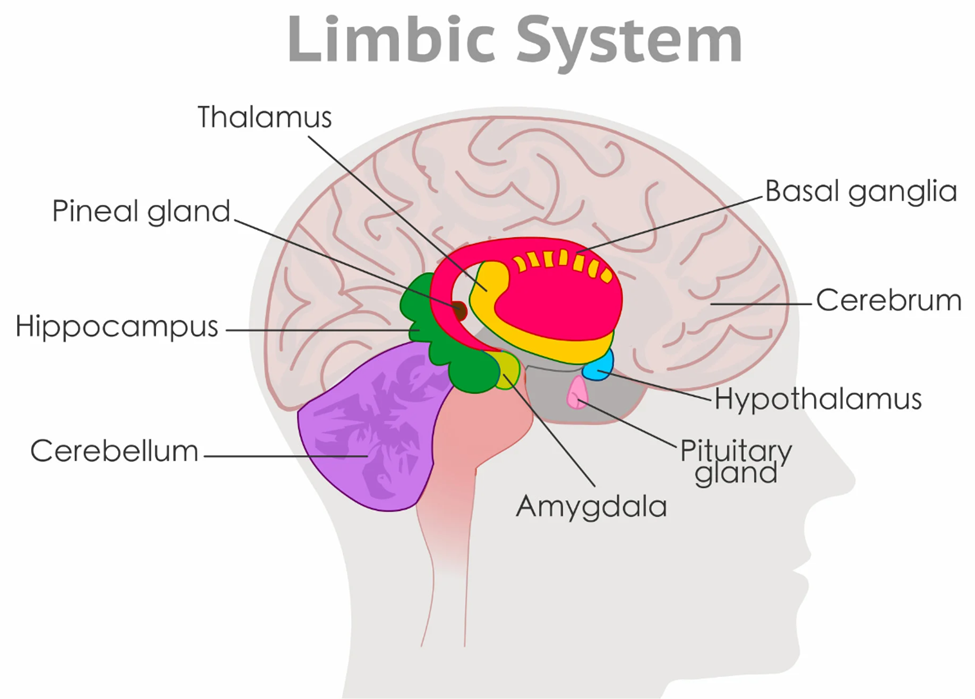The nurse is working with a client that is displaying psychotic behavior with poorly controlled emotions. The family of the client asks, What part of the brain controls emotions?"
The Parietal Lobe
The Endocrine System
The Limbic System
The Occipital Lobe
The Correct Answer is C
A. The Parietal Lobe: The parietal lobe is primarily involved in processing sensory information, such as touch, temperature, and pain, as well as spatial awareness and perception. It is not directly responsible for controlling emotions.
B. The Endocrine System: The endocrine system consists of glands that secrete hormones into the bloodstream, regulating various bodily functions. While hormones can influence emotions, the endocrine system as a whole is not specifically responsible for controlling emotions.
C. The Limbic System: The limbic system, including structures like the amygdala, hippocampus, and hypothalamus, plays a crucial role in regulating emotions, memory, and motivation. The amygdala, in particular, is involved in processing emotions, especially fear and aggression, making the limbic system the correct answer.
D. The Occipital Lobe: The occipital lobe is primarily responsible for processing visual information, such as color, shape, and movement, and is not directly involved in controlling emotions.

Nursing Test Bank
Naxlex Comprehensive Predictor Exams
Related Questions
Correct Answer is A
Explanation
A. Restate a feeling or thought the patient has expressed: Restating a feeling or thought the patient has expressed shows active listening and genuine interest in understanding the client's perspective. It demonstrates empathy and encourages further communication.
B. Make a judgment about the client's problem: Making a judgment about the client's problem can be perceived as non-empathetic and may hinder effective communication. It can create barriers and reduce the client's willingness to share their thoughts and feelings openly.
C. Say, "I understand what you're saying": While saying "I understand what you're saying" can show acknowledgment, it may come across as superficial or dismissive if not accompanied by active listening behaviors. It's important to demonstrate understanding through active listening techniques rather than just verbal reassurances.
D. Ask a direct question, such as, "Did you feel angry?": Asking direct questions can be helpful for clarification or gathering specific information, but it may not necessarily communicate genuine interest in listening. Direct questions should be used appropriately and complemented with active listening skills to foster effective communication.
Correct Answer is B
Explanation
A. Antidepressant Drugs: Antidepressant drugs are not typically used as first-line treatment for manic episodes in bipolar disorder. In fact, they can sometimes trigger manic episodes or rapid cycling in individuals with bipolar disorder, so they are generally used cautiously and in combination with mood-stabilizing medications.
B. Mood-Stabilizing Drugs: Mood-stabilizing drugs, such as lithium, valproate, carbamazepine, and lamotrigine, are commonly used to treat manic episodes in bipolar disorder. These medications help stabilize mood swings, reduce manic symptoms (such as elevated mood, irritability, impulsivity), and prevent future episodes of mania or depression.
C. Antipsychotic Drugs: Antipsychotic drugs are often used to manage acute manic episodes in bipolar disorder. They can help reduce symptoms such as agitation, hallucinations, and delusions commonly seen during manic episodes. Some antipsychotic medications also have mood-stabilizing properties.
D. Anxiolytics: Anxiolytics, such as benzodiazepines, are primarily used to manage anxiety symptoms. While they may be helpful for individuals with bipolar disorder who experience anxiety alongside their mood symptoms, they are not specifically targeted at treating manic episodes.
Whether you are a student looking to ace your exams or a practicing nurse seeking to enhance your expertise , our nursing education contents will empower you with the confidence and competence to make a difference in the lives of patients and become a respected leader in the healthcare field.
Visit Naxlex, invest in your future and unlock endless possibilities with our unparalleled nursing education contents today
Report Wrong Answer on the Current Question
Do you disagree with the answer? If yes, what is your expected answer? Explain.
Kindly be descriptive with the issue you are facing.
